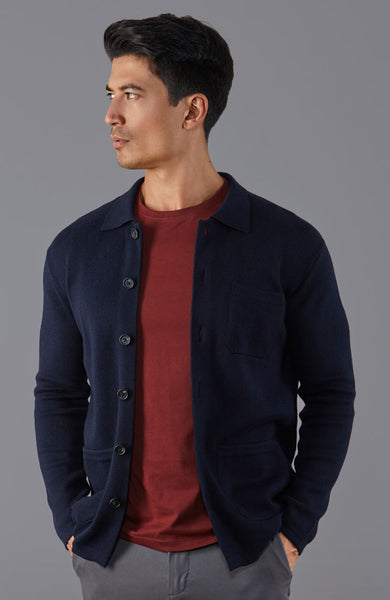The History of the Men's Work Shirt
In recent years the men's work shirt has re-emerged as something of a wardrobe staple for men and women alike. Easy to style with everyday denim, wear on its own or layered with a t-shirt, most people consider work shirts as somewhere between a garment in its own right and a light jacket for warmer weather.
For our latest menswear collection, we've introduced a number of more tailored knitted jackets and cardigans, from our shawl collar cardigan to our deconstructed blazer, to extend your Paul James wardrobe from only traditional knitwear and introduce innovative and incredibly comfortable knitted fabrics. We also designed our take on the work shirt, offering a midweight cotton knitted jacket that takes inspiration from utility work shirts and their boxy regular fit. In this blog post, we explore the history of the work shirt and its legacy.

The Evolution Of Men's Work Shirts
Shirts have long been a staple of menswear. In the form most recognisable to its modern incarnation, the work shirt appears in the late 1800s, with brands such as Levi's developing clothing suitable for labourers and miners. Although few samples have survived from the turn of the century, vintage catalogues and magazines from the early 1900s suggest that many men's everyday work shirts were pullovers made from a variety of durable fabrics like chambray, wool and moleskin.
Designed to be worn during manual labour, much attention was paid to both the practical construction of the garment and reinforcing its seams and hems to ensure it would withstand regular wear and tear, preventing ripping and fraying. They were designed with care and attention paid to their practicality and adaptability, with considerations made to comfort through the introduction of ventilation. The use of breathable fabrics like cotton, and even the addition of vent holes with rivets, were added to help keep the wearer feeling cool and comfortable.

By the 1930s, the impact in the US of the Great Depression and Dust Bowl meant that many agricultural workers were displaced and forced to relocate to cities which left its mark on the consumer. Designs were for some time simplified, reducing the prices of products. However, as Americans became more affluent again, with more choices of brands, designers began introducing practical and unique touches. Expensive riveted vent holes, which had been removed during the Depression to decrease design and manufacturing costs, remained abandoned. Instead, unique asymmetrical pockets, designed to protect cigarettes from sweat with double layering while still allowing the wearer easy access to them, and long pockets, suitable for tobacco tins, began to appear in designs. Increased reinforcement across the sleeves, seams and fronts also indicated that the shopper of this era was still conscious of investing in a hardwearing and durable item that was made to last.

With the outbreak of war at the end of the 1930s, the 40s is marked by more military inspired styles. By this period much of the design of the work shirt began to standardise, and by the 1950s and 1960s, many began to adopt a slimmer, more form-fitting cut than the older, more baggy style original work shirts. Along with the introduction of lightweight jackets, designed to be worn over work shirts and overalls to provide more arm protection and additional pockets.
Inspired to invest in your own work shirt? Made from pure cotton, the Benjamin jacket is constructed using a half Milano knit structure, with natural horn buttons for a timeless look.
Made from midweight cotton (674gms), we used a 12 gauge machine to create this tightly knitted fabric. Durable and comfortable for everyday wear, with patch and chest pockets and a functional inside pocket, this stylish shirt is durable and easy to style - try wearing it on its own or layered with a t-shirt and jeans for effortless off-duty style on the weekend.
Related Articles:





















Leave a comment